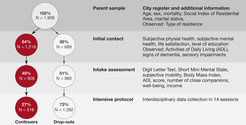Selectivity
To What Extent Are the BASE Findings Generalizable?
Special attention was paid to the issue of selectivity in BASE to answer this question. Examining this issue makes it necessary to examine whether the BASE samples are representative of the older population, thus allowing the findings to be generalized. In longitudinal studies of aging, sample attrition due to illness and death over time is a particular challenge. Nevertheless, it is rarely analyzed systematically.
Selectivity in the BASE core sample as compared to the verified parent sample was found to be relatively low. The cross-sectional finding of the Berlin Aging Study can thus be generalized with quite good reliability and validity. In the longitudinal continuation of the study, selectivity has increasingly strong effects. However, as these effects were repeatedly explicitly examined, it is possible to take into account selectivity-related biases when evaluating the study's findings.
Selectivity Analyses

Methods
On the first occasion of measurement various participation levels were differentiated. Basic data from the Berlin city registry were even available for "non-participants" in the Berlin Aging Study (see figure above). Further data were added at every further participation level (Short Initial Assessment, Intake Assessment, Intensive Protocol). By successively comparing the samples at the different participation levels using the available data, it was possible to examine the selectivity effects (cf. Lindenberger et al., 2001). The longitudinal selectivity analyses were carried out in an equivalent manner (see Ghisletta, McArdle, & Lindenberger, 2006; Lindenberger, Singer, & Baltes, 2002).
Why Is Selectivity Important?
If it is mainly younger, healthy, and active people who participate in a study of aging (as is often the case when volunteers are examined), the emerging image of old and aging can be too positive. In BASE, a stratified random sample from the obligatory city registry was drawn (including, among others, elders living in a retirement home). Nevertheless, it would still be possible that only the healthier and cognitively fitter people would be prepared to participate in this complex study. The selectivity analyses make it possible to show that the positive bias of the image of old age and aging described by BASE is confined to a narrow range. BASE can thus provide a good representation of the reality of old age and aging.
Selected Publications
Ghisletta, P., McArdle, J. J., & Lindenberger, U. (2006). Longitudinal cognition-survival relations in old and very old age: 13-year data from the Berlin Aging Study. European Psychologist, 11, 204–223. https://doi.org/10.1027/1016-9040.11.3.204
Lindenberger, U., Gilberg, R., Little, T. D., Nuthmann, R., Pötter, U., & Baltes, P. B. (2001). Sample selectivity and generalizability of the results of the Berlin Aging Study. In P. B. Baltes & K. U. Mayer (Eds.), The Berlin Aging Study: Aging from 70 to 100 (pp. 56–82). Cambridge University Press. Full text
Lindenberger, U., Singer, T., & Baltes, P. B. (2002). Longitudinal selectivity in aging populations: Separating mortality-associated versus experimental components in the Berlin Aging Study (BASE). Journal of Gerontology: Psychological Sciences, 57B, P474–P482. https://doi.org/10.1093/geronb/57.6.P474
See also Publications
